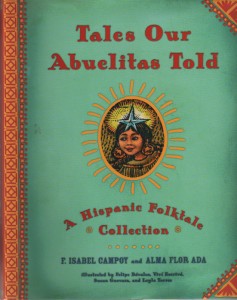By Bianca Schulze, The Children’s Book Review
Published: September 30, 2011

F. Isabel Campoy
F. Isabel Campoy is a scholar devoted to the study of language acquisition. She is a well-known author of numerous children’s books in the areas of poetry, theatre, folktales, biographies, and art. She is the recipient of many notable awards, including the Reading the World Award 2004, for “Cuentos que contaban nuestras abuelitas;” and the Junior Library Guild Premier Selection Award, 2006.
TCBR: As a writer, you have a strong focus on the culture and civilization of the Hispanic world. Can you share a little on your background and how you became a children’s book writer?
F. Isabel Campoy: I cannot remember a time in my life in which I wasn’t part of the world of children’s literature. As soon as I learned to read I became the person that teachers chose to read out loud to the rest of the class while they did art, or sewing. I had a good voice and I couldn’t hold a thread and needle for more than two seconds, so it was a perfect match to keep everyone busy. That practice stimulated the writer in me and when I was eleven-years-old I published my first tale in a local magazine. I continued writing throughout my childhood. When I came to the U.S. for the first time at age fifteen in 1963, writing kept me alive through the difficult moments of missing my family (I was here as an AFS exchange student), and conquering my fears after the tragic assassination of John Fitzgerald Kennedy on November of that year.
My first job after college was as an assistant editor in Madrid. I applied to the position because it was my way to be part of the publishing world. Later I was offered the opportunity to co-author with Phillip Locke a series for the teaching of English, my responsibility being to provide the literary texts. I left publishing many years later. At the time, I was a Senior Acquisitions Editor for College publications in a company in Boston. I realized then that the joy of publishing others was hiding my fear to publish my own manuscripts… so I finally quit everything and became a full time writer.
I love to travel. I am interested in the places, the people, and their histories. When I began writing for children I wanted to contribute to present the cultural richness of Latino history, art, and literature for readers in this country. There is much to be written about our culture.
 Tales Our Abuelitas Told: A Hispanic Folktale Collection is one of the many books you have written with Alma Flor Ada. Why do you think so many readers are drawn to your retellings of these particular folktales?
Tales Our Abuelitas Told: A Hispanic Folktale Collection is one of the many books you have written with Alma Flor Ada. Why do you think so many readers are drawn to your retellings of these particular folktales?
Authors love all their books, but there are some that connect with you in a very personal way. “Tales Our Abuelitas Told” was published the year I lost my mother. She was the greatest storyteller, imaginative, soft spoken, and these were tales
 This year is the 15th anniversary for El día de los niños/El día de los libros! Happy birthday to this wonderful celebration of children and books from all linguistic and cultural backgrounds!
This year is the 15th anniversary for El día de los niños/El día de los libros! Happy birthday to this wonderful celebration of children and books from all linguistic and cultural backgrounds!
There are lots of celebrations going on and one I’m particularly excited about is the Pura Belpré Celebración at the ALA Annual Conference in New Orleans this June. Organizers tell us that they’re going to celebrate it as a Quinceañera with a traditional promenade. It’s going to be fabulous – we only hope we can sneak away from our booth long enough to participate!
For your collections, here are some Spanish and bilingual books to consider for your Día celebrations:
- Ada, Alma Flor and F. Isabel Campoy ¡MUU, MOO!: Rimas de animales/Animal Nursery Rhymes. Illus. Vivi Escriva. 2010
- Ada, Alma Flor and F. Isabel Campoy TEN LITTLE PUPPIES/Diez Perritos. Illus. Ulises Wensell. 2011
- Brown, Monica SIDE BY SIDE/Lado a lado. Illus. Joe Cepeda. 2010
- Dorros, Arthur MAMA AND ME. Illus. Rudy Gutierrez. 2011
- Dorros, Arthur RADIO MAN/Don radio. 1997 (paperback)
- Guy, Ginger Foglesong BRAVO! Illus. Rene King Moreno. 2010
- Guy, Ginger Foglesong MY GRANDMA/Mi abuelita. Illus. Vivi Escriva. 2007
- Lacamara, Laura FLOATING ON MAMA’S SONG/Flotando en la canción de mamá. Illus. Yuyi Morales. 2010
- Martinez, Rueben ONCE UPON A TIME/Habia una vez: Traditional Latin American Tales/Cuentos tradicionales latinoamericanos. Illus. Raul Colon. 2010
- Mora, Pat BOOK FIESTA! Illus. Rafael Lopez. 2009
- Mora, Pat WIGGLING POCKETS/Los bolsillos saltarines. Illus. Maribel Suarez. 2009
- Reiser, Lynn Tortillas and Lullabies/Tortillas y cancioncitas. Illus. Corazones Valientes. 2008
This list is by no means exhaustive (many of these authors and illustrators are prolific with rich and beautiful books in their backlist), but hopefully it’ll help get you started.
And make sure to check out the Día website – there’s a wealth of information about hosting your own Día event, events going
 Little Brother and I have been having fun recently reading nursery rhymes in Spanish and English, from ¡Pío Peep!, a delightful book of rhymes from Spain and Latin American countries, selected by Alma Flor Ada and F. Isabel Campoy (Harper Collins, 2003). In their introduction they say that they chose rhymes that resonated from their own childhoods, and also ones that were clear favorites with “the numerous children – Mexican, Puerto Rican, Cuban, Dominican, and Central American – with whom we have worked.” The rhymes are accompanied by an English Adaptation by Alice Schertle, who provides the key for these rhymes to be enjoyed as nursery rhymes by English-speakers as well, in all their rhythmic, chantable, sometimes nonsensical, sometimes dreamlike glory.
Little Brother and I have been having fun recently reading nursery rhymes in Spanish and English, from ¡Pío Peep!, a delightful book of rhymes from Spain and Latin American countries, selected by Alma Flor Ada and F. Isabel Campoy (Harper Collins, 2003). In their introduction they say that they chose rhymes that resonated from their own childhoods, and also ones that were clear favorites with “the numerous children – Mexican, Puerto Rican, Cuban, Dominican, and Central American – with whom we have worked.” The rhymes are accompanied by an English Adaptation by Alice Schertle, who provides the key for these rhymes to be enjoyed as nursery rhymes by English-speakers as well, in all their rhythmic, chantable, sometimes nonsensical, sometimes dreamlike glory.
Here’s a taster: “El Barquito” uses repetition of whole phrases to create its narrative tension; the English also repeats but only single words:
There was, was, was
a little boat, boat, boat,
who never, never, never
learned to float, float, float.
[...]
And if this silly story doesn’t
sink, sink, sink,
we’ll have to tell it one more time,
I think, think, think.
Little Brother loves the potential for being very annoying, repeating the rhyme over and over and over; and I love the nonsensical inversion at the end, of the story rather than the boat not sinking. The rhythm is so snappy, I think it’s going to be lurking at the back of my mind for a while to come, even without Little Brother’s assistance!
As in all nursery rhymes across cultures, this selection includes the themes of nature and family; there are short, clapping rhymes, counting rhymes and lullabies; and they encompass everyday routines in a child’s life, and flights of imagination. Add to all this Viví Escrivá’s captivating illustrations and you really do have one special book.
This week’s Poetry Friday is hosted by Irene Latham over at Live. Love. Explore! Head on over.
And P.S. Don’t forget to take a look at our 1,000th post, with the chance of winning a Spirit of PaperTigers 2010 book set. Deadline for entries is Wednesday 19th January…
By Luisa LaFleur, The Children’s Book Review
Published: July 26, 2010
I’ve recently read a few new books that aim to teach our children Spanish the old-fashioned way: with songs and nursery rhymes. There are a plethora of computer programs that can be used to learn foreign languages but many language teachers will tell you that vocabulary and practice are the only real ways to learn a foreign language. What better way to learn new words and practice them over and over again, but by learning catchy songs and nursery rhymes?
Following are some recently published books that caught my eye:
 Buenas Noches, Amigos
Buenas Noches, Amigos
by Heide “Pina” Madera (Author), Christina Spangler (Illustrator)
Reading level: Ages 0-3
Paperback: 14 pages
Publisher: Sing-A-Lingo (2009)
Source of book: Publisher
Buenas Noches, Amigos by Heide “Pina” Madera is a “singable” book that can be incorporated into a child’s bedtime routine easily since it follows a little boy, his cat, and a mouse on their journey from bath to bed to sleep. The book comes with printed music and words for two songs and–in a more modern twist–these can be downloaded from the publisher’s website to accompany the bedtime routine.
 Muu, Moo!: Rimas de animales/Animal Nursery Rhymes
Muu, Moo!: Rimas de animales/Animal Nursery Rhymes
by Alma Flor Ada and F. Isabel Campoy (Authors), Rosalma Zubizarreta (English versions) and Vivi Escriva (Illustrator)
Reading level: Ages 2-7
Hardcover: 48 pages
Publisher: HarperCollins (2010)
Source of book: Publisher
Muu, Muu! Animal Nursery Rhymes by Alma Flor Ada and F. Isabel Campoy is a collection of traditional Spanish nursery rhymes and their English translations. The book is full of beautiful Latin American-inspired illustrations with lots of colorful images.
©2010 The Childrens Book Review. All Rights Reserved.
.
Share and Enjoy:


 Tales Our Abuelitas Told: A Hispanic Folktale Collection is one of the many books you have written with Alma Flor Ada. Why do you think so many readers are drawn to your retellings of these particular folktales?
Tales Our Abuelitas Told: A Hispanic Folktale Collection is one of the many books you have written with Alma Flor Ada. Why do you think so many readers are drawn to your retellings of these particular folktales?




 Little Brother and I have been having fun recently reading nursery rhymes in Spanish and English, from ¡Pío Peep!, a delightful book of rhymes from Spain and Latin American countries, selected by
Little Brother and I have been having fun recently reading nursery rhymes in Spanish and English, from ¡Pío Peep!, a delightful book of rhymes from Spain and Latin American countries, selected by  Buenas Noches, Amigos
Buenas Noches, Amigos Muu, Moo!: Rimas de animales/Animal Nursery Rhymes
Muu, Moo!: Rimas de animales/Animal Nursery Rhymes
